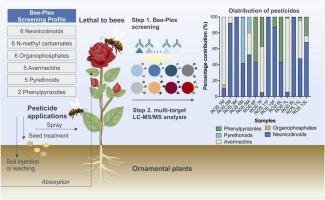Discovery of multiple bee-hazardous pesticides in ornamental plants via the Bee-Plex multi-target microsphere screening method
IF 12.2
1区 环境科学与生态学
Q1 ENGINEERING, ENVIRONMENTAL
引用次数: 0
Abstract
Exposure to pesticides is one of the main drivers of global bee decline. However, the occurrence of pesticides in bee-attracting crops remains underexposed due to the lack of efficient on-site screening approaches for multi-analyte monitoring. Utilizing color-encoded superparamagnetic microspheres, we constructed a portable 8-plex indirect competitive microsphere-based immunoassay for the simultaneous determination of multiple bee-hazardous residues (Bee-Plex). Through a single measurement within 40 min, Bee-Plex exhibited high sensitivities with IC50values of 0.04, 0.08, 0.14, 0.15, 0.78, 0.86, 7.72, and 8.79 ng/mL for imidacloprid, parathion, fipronil, emamectin, carbofuran, chlorpyrifos, fenpropathrin and carbaryl, respectively. Moreover, the implementation of multiple broad-specific antibodies enables a wide-range screening profile for 30 pesticides and pesticide metabolites, detecting 6 neonicotinoids, 6 N-methyl carbamates 6 organophosphates, 5 avermectins, 5 pyrethroids and 2 phenylpyrazoles. The combination of Bee-Plex screening (93 % accuracy) and LC-MS/MS confirmatory analysis revealed contaminations of neonicotinoids (100 %) and avermectins (70 %) in roses, with occurrence frequencies of 79 %, 79 %, 21 %, 21 %, 7 %, and 7 % for imidacloprid, acetamiprid, clothianidin, thiacloprid, imidaclothiz, and nitenpyram, respectively. Above all, this study offers a powerful analytical tool for rapid screening of multiple bee-hazardous pesticides, offering new insights in the occurrence of multi-pesticide contamination in ornamental plants.

通过 Bee-Plex 多靶标微球筛选法发现观赏植物中多种危害蜜蜂的农药
接触农药是导致全球蜜蜂数量下降的主要原因之一。然而,由于缺乏高效的多分析物监测现场筛查方法,蜜蜂引诱作物中农药的发生率仍未得到充分暴露。利用彩色编码超顺磁性微球,我们构建了一种基于微球的便携式 8 重间接竞争性免疫测定法(Bee-Plex),用于同时测定多种危害蜜蜂的残留物。通过 40 分钟内的单次测定,Bee-Plex 表现出很高的灵敏度,对吡虫啉、对硫磷、氟虫腈、乙霉威、呋喃丹、毒死蜱、苯丙炔菊酯和西维因的 IC50 值分别为 0.04、0.08、0.14、0.15、0.78、0.86、7.72 和 8.79 纳克/毫升。此外,通过使用多种广谱特异性抗体,可对 30 种农药和农药代谢物进行大范围筛选,检测出 6 种新烟碱类、6 种 N-甲基氨基甲酸酯类、6 种有机磷类、5 种阿维菌素类、5 种拟除虫菊酯类和 2 种苯基吡唑类。结合 Bee-Plex 筛选(准确率达 93%)和 LC-MS/MS 确认分析,发现玫瑰中含有新烟碱类(100%)和阿维菌素类(70%),其中吡虫啉、啶虫脒、噻虫嗪、吡虫啉和硝虫嗪的出现频率分别为 79%、79%、21%、21%、7% 和 7%。总之,这项研究为快速筛选多种对蜜蜂有害的农药提供了一个强大的分析工具,为观赏植物中多种农药污染的发生提供了新的见解。
本文章由计算机程序翻译,如有差异,请以英文原文为准。
求助全文
约1分钟内获得全文
求助全文
来源期刊

Journal of Hazardous Materials
工程技术-工程:环境
CiteScore
25.40
自引率
5.90%
发文量
3059
审稿时长
58 days
期刊介绍:
The Journal of Hazardous Materials serves as a global platform for promoting cutting-edge research in the field of Environmental Science and Engineering. Our publication features a wide range of articles, including full-length research papers, review articles, and perspectives, with the aim of enhancing our understanding of the dangers and risks associated with various materials concerning public health and the environment. It is important to note that the term "environmental contaminants" refers specifically to substances that pose hazardous effects through contamination, while excluding those that do not have such impacts on the environment or human health. Moreover, we emphasize the distinction between wastes and hazardous materials in order to provide further clarity on the scope of the journal. We have a keen interest in exploring specific compounds and microbial agents that have adverse effects on the environment.
 求助内容:
求助内容: 应助结果提醒方式:
应助结果提醒方式:


